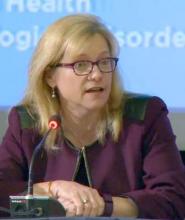Since Colorado is “ground zero” for medical marijuana use, the rest of the nation can learn from how pediatric neurologists there are taking care of children with seizures who use cannabinoids.
Dr. Amy Brooks-Kayal, chief of pediatric neurology at the University of Colorado at Denver, Aurora, shared her facility’s experiences at Marijuana and Cannabinoids: A Neuroscience Research Summit sponsored by the National Institutes of Health.
“Our odyssey in Colorado started before I arrived there,” she said, since the state has allowed medical use of marijuana since November 2000. Of the state’s 107,798 patients who hold the “red card” that permits medical marijuana use, 349, or about 0.3%, are minors.
Seizures are a relatively rare reason for medical marijuana use, and Dr. Brooks-Kayal said that she is not aware of any neurologists or pediatricians who prescribe cannabinoids for pediatric seizures (“red cards” can be issued by any physician who has a relationship with the patient; two physicians are needed for minors).
To examine the use of medical marijuana in Colorado for children with seizure disorders, Dr. Craig Press, then a pediatric neurology resident at Children’s Hospital Colorado, and his coauthors studied 75 pediatric seizure patients who used medical marijuana (Epilepsy Behav. 2015 Apr;45:49-52). “This was completely an observational study. Obviously, we had no ability to determine what was in the substances given, other than parental report,” Dr. Brooks-Kayal said.
Overall, 33% of parents reported a greater than 50% reduction in seizures; this group was judged to be responders, with no significant difference in response rate by seizure type. A variety of cannabis products were used, including cannabidiol alone and cannabidiol with other oral cannabis extracts (OCEs). All produced similar response rates.
However, only 30 patients had pre- and post-cannabis EEGs. Of this group, none of the cannabis responders had an improvement in their EEGs after cannabis use, whereas three of the nonresponders showed EEG improvement. “The most interesting finding that we saw was that the response rate dramatically varied depending on whether the families had moved out of state,” Dr. Brooks-Kayal said. Families who had moved to Colorado from another state for treatment were three times more likely to report response to OCEs, compared with those families who were from Colorado (16/34, 47%, vs. 9/41, 22%; odds ratio, 3.16; P less than .025).
This result, she said, raised the possibility that “the degree of investment that the family had made in getting this therapy might be impacting the parents’ perception of response.”
Since state policies vary widely and “federal policies are fragmented,” it’s hard to know what to do when a family comes to you asking about cannabis for pediatric seizure control, Dr. Brooks-Kayal said.
Dr. Brooks-Kayal outlined the approach used at Children’s Hospital Colorado. There, “providers do not recommend use of cannabinoids for treatment of epilepsy outside of a clinical trial,” she said.
However, families are provided with the most current information about cannabinoids. This includes being frank about the current lack of evidence regarding efficacy and safety, as well as unknowns around dosing and drug interactions. She said providers also share concerns about what’s in artisanal marijuana products, since purity and consistency of content aren’t regulated.
It’s critical for families to feel comfortable disclosing whether they’re using cannabinoids for their children with seizures, so providers can help track safety and efficacy. Disclosure may be more likely if you reinforce that you won’t stop caring for these children if they are on cannabinoids, Dr. Brooks-Kayal said. “We strongly encourage disclosure,” and it’s a standard part of intake at every appointment to ask about cannabinoids, she said.
When cannabinoids are being used, Dr. Brooks-Kayal recommends obtaining the following labs at baseline and monthly thereafter: CBC, liver function tests, basic metabolic panel, and trough anti-seizure medication levels. Clobazam, N-desmethylclobazam, and valproic acid levels have all been seen to change with concomitant cannabinoid use, she said.
“We ask families not to change other medications,” Dr. Brooks-Kayal said. Her practice frequently sees unwanted status epilepticus when other medications are stopped and cannabinoids started, she said. “That is a huge risk.”
To help families and providers track efficacy when cannabinoids are being used, Dr. Brooks-Kayal asks families to keep a seizure diary. She obtains a baseline EEG and repeats it about 3 months after the baseline. Since the EEG should capture seizure frequency, the length of the EEG is tailored to the patient’s seizure frequency. For Dr. Brooks-Kayal’s patients, this means she often obtains 24-hour EEGs.
If it’s appropriate, families can enroll their children in an observational research study, and families can also consider participating in pharmaceutical double-blind, placebo-controlled trials. Other practical tips include standardizing the way you care for cannabinoid-using children in your practice, and working with hospital administrators and the inpatient pharmacy in advance about how use of these products will be addressed for inpatients.


